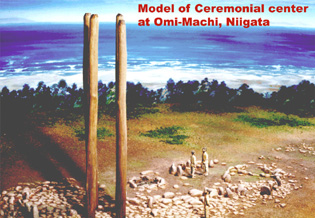Final Jomon sub-period
The Final Jomon, also called the Latest Jomon by other authors, is a time of variability across the Japanese archipelago. In northeastern Japan, where over 50% of the Final Jomon sites are located, the Jomon lifestyle continued with some modifications. Excavations reveal that the subsistence economy depended on the exploitation of chestnuts and other nuts, fishing and hunting, and gathering shellfish. An elaborate harpoon technology is also developed in this region.
A variety of crafts and ritual objects are also developed in Tohoku during the Final Jomon. Kamegaoka style pottery is developed in Tohoku. This style has both carved designs and the use of surikeshi jomon cord marking. Often it is lacquered. Wooden objects with black and red lacquer decorations are also popular at this time. Several large stone circles also date to this time period.

Nearly 300 sites are found in Kyushu which date to the Final Jomon sub-period. Compared to the Tohoku region, this island has a much lower settlement density. There is also a noticeable absence of ceremonial centers in southwestern Japan. Pottery is made in a much simpler fashion; pottery is characterized by black burnished wares with a single band for decoration. Recalling earlier traditions from the Middle Jomon sub-period, storage pits for nuts and chipped stone axes are common. The chipped stone axes are seen by some authors as being used to cultivate plants such as barley or rice.
While the evidence points to plant cultivation occurring during the Final Jomon in parts of Japan, its impact on the Jomon people was minimal. First, these plants only supplemented the daily diet, a large percentage of the daily calories were believed to still be obtained from hunting and gathering. Second, in the succeeding Yayoi period, four major changes are seen as occurring in society. They are: 1) the dependence on wet rice agricultural for subsistence; 2) procurement and manufacture of metal tools and weapons; 3) active contact with the East Asian continent; and 4) social stratification and later, the emergence of political groups.
| <back to index | references> |
 English (UK)
English (UK)  Ру́сский
Ру́сский  中文
中文  Portugues
Portugues  한국어
한국어  Espanol
Espanol  Deutsch
Deutsch